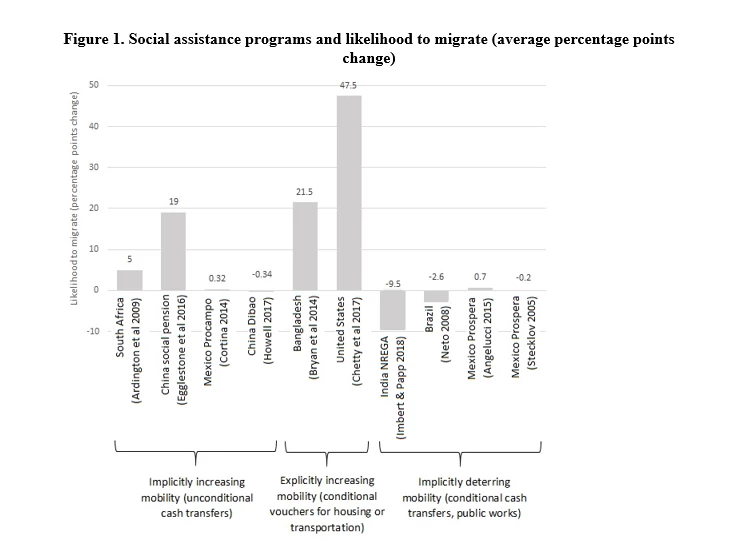With 875 million people “on the move” by 2050, there is an durge of interest on how development policy interacts with such a complex phenomenon. Cash transfers, one of the hottest development topics, are surprisingly missing from the debate.
A new paper co-authored with Samik Adhikari, Should I Stay or Should I Go, takes stock of the evidence on how cash-based social assistance affects people’s international or domestic mobility.
Three findings stand out.
First, there is a dearth of empirical scrutiny. Our meta-analysis considered 269 papers related to the topic, with less than a dozen providing relevant and solid evidence. This is in stark contrast with evidence on other salient effects on labor markets or human capital.
Second, program design significantly affects mobility. Parameters such as benefit size, the profile of beneficiaries, predictability of transfers, and conditions may all feed into households’ migration calculus.
We categorized programs into three groups: among schemes that may implicitly encourage migration, like unconditional cash transfers, the probability to move soared between 0.32 and 25 percentage points. Such programs in Mexico (Procampo), China (social pensions) and South Africa relax liquidity constraints, and new delivery technologies can make benefits more portable than before.
Such a mobility-spurring effect was amplified in the second group of programs. Voucher pilots for moving to a better house in the United States, or covering for transportation costs incurred while moving to cities in Bangladesh, were designed to incentivize migration, the probability of which increased between 20 and 55 percentage points.
Among those that may implicitly deter migration, such as conditional cash transfers (Mexico and Brazil) and public works in India, the likelihood of moving declined between 0.22 and 11 percentage points. This is because programs tend to be ‘place-based’ requiring work and co-responsibilities in the areas where people live. Figure 1 summarizes results from the reviewed impact evaluations.
Third, migration can also be affected via knock-on effects. Indeed, beneficiaries can use the program as collateral for taking up loans to finance migration, like in Mexico. Or programs may allow others to migrate within the household or community, observed in China (Dibao) and South Africa.
Overall, our interpretation of the evidence is that transfers can affect the degree or likelihood of migration. This is important given the magnitude of migration flows. Yet transfers may not be the determinant of mobility decision-making. People in poor places migrate for a variety of reasons – work, education, services, marriage, security, and more. Hence the inverted U-shaped relationship between migration and development, i.e., at lower level of income migration increases even as incomes gradually rise, before declining at higher levels of income.
But in many low and middle-income countries, structural transformation—a process underpinned by domestic urban-rural mobility— is generally haphazard and at times puzzling. The performance of this process, including the quality and distribution of jobs and services, may ultimately affect international migration too. There is an untapped agenda on how to think of cash transfers, and social protection more widely, as part of a system-wide process with mobility at its core.




Join the Conversation